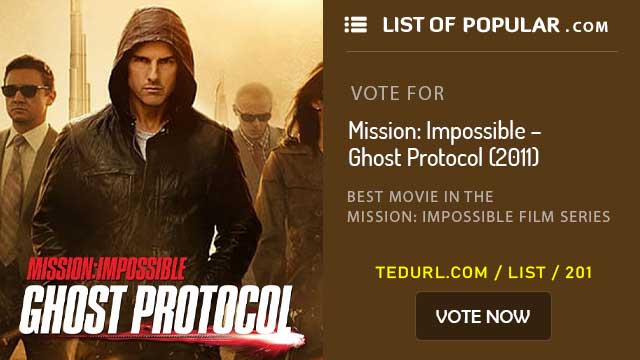Mission: Impossible – Ghost Protocol (2011) : Best Film in the Series
Mission: Impossible – Ghost Protocol (2011): A Landmark in Practical Action
Mission: Impossible – Ghost Protocol (2011), directed by Brad Bird in his live-action directorial debut, redefined the franchise's commitment to spectacular, practical stunts and ensemble storytelling. Following the success of J.J. Abrams' *M:I-III*, *Ghost Protocol* propelled Ethan Hunt and his team into an exhilarating global adventure, widely regarded as one of the strongest entries in the entire series. It brilliantly balanced breathtaking action with compelling character dynamics, setting a new benchmark for the spy genre.
The "Ghost Protocol" and a Disavowed Team
The film kicks off with Ethan Hunt (Tom Cruise) breaking out of a Russian prison, quickly leading into a mission to infiltrate the Kremlin. When the Kremlin is bombed, the IMF is framed for the attack, leading to the activation of "Ghost Protocol" – the disavowal of the entire Impossible Missions Force. Ethan and his makeshift team, consisting of intelligence analyst William Brandt (Jeremy Renner), tech specialist Benji Dunn (Simon Pegg), and femme fatale Jane Carter (Paula Patton), are forced to operate off the grid. Their objective is to prevent nuclear war, orchestrated by the cunning nuclear extremist Kurt Hendricks (Michael Nyqvist), who believes global destruction is the path to peace. This premise cleverly removes the safety net of the IMF, forcing the team to rely solely on their wits, each other, and their incredible skills.
Iconic Stunts and Global Scale
Ghost Protocol is perhaps best known for its jaw-dropping, practically executed stunts, with the most famous being Ethan Hunt's scaling of the Burj Khalifa in Dubai. Tom Cruise famously performed this sequence himself, harnessed to the side of the world's tallest building, providing an unparalleled sense of vertigo and danger. This commitment to real, in-camera action became a signature element for the franchise moving forward. Beyond Dubai, the film takes the audience on a whirlwind tour from Moscow to Budapest, Mumbai, and Seattle, showcasing a truly global scale. Each location offers unique challenges and stunning backdrops for the film's meticulously choreographed set pieces, from the sandstorm chase in Dubai to the elaborate car park brawl in Mumbai.
The Power of the Ensemble
While Tom Cruise remains the undeniable star, *Ghost Protocol* significantly elevates the importance of the ensemble cast. Jeremy Renner's William Brandt is introduced as a more ambiguous character with a mysterious past, eventually proving his worth as a capable field agent. Simon Pegg's Benji Dunn evolves from a strictly tech-support role to an integral part of the on-the-ground team, providing both comic relief and crucial assistance. Paula Patton's Jane Carter is a formidable and emotionally driven agent with a personal vendetta against Hendricks' associate. The camaraderie and reliance among these characters are central to the film's success, making the team feel genuinely cohesive and their victories more satisfying. This film solidified the notion that the IMF is not just Ethan Hunt, but a collective of extraordinary individuals.
Critical Acclaim and Franchise Evolution
Upon its release, Mission: Impossible – Ghost Protocol received widespread critical acclaim, with many praising Brad Bird's direction, the breathtaking action, the compelling performances, and the sharp screenplay. It was a massive commercial success, reigniting interest in the franchise and setting a high bar for future installments. The film proved that the *Mission: Impossible* series could not only maintain its quality but continuously innovate and surprise audiences with its dedication to thrilling, practical espionage action. It remains a testament to the idea that a compelling story, strong characters, and a genuine commitment to spectacular filmmaking can create truly unforgettable cinematic experiences.

